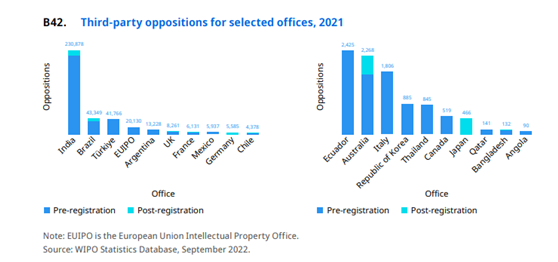WIPO Indicators and EAC report show India’s trademark landscape is in excellent health
India’s Economic Advisory Council (EAC) – an independent body that advises the national government on economic issues – has submitted a report to the country’s prime minister on the state of India’s IP regime titled ‘Why India Needs To Urgently Invest In Its Patent Ecosystem?’. Emphasising the importance of a progressive IP landscape to national growth and innovation, the report examines the advancement of intellectual property in India and identifies crucial gaps. It also features some illuminating statistics on the development of India’s stature in the global IP community and highlights a shortage of people at the country’s IP Office as the key reason for delayed decisions on contentious matters. The EAC report works hand-in-hand with the recently released WIPO Indicators 2022, which too highlights the remarkable growth of India’s IP numbers.
Trademark filings in India
According to the EAC report, trademark filings in India have surged significantly in recent years. In 2020, India ranked fifth in number of trademark applications filed globally, trailing only China, the United States, the Islamic Republic of Iran and the European Union. From 2013 to 2014 and from 2021 to 2022, the country saw a stunning 125% increase in its number of trademark filings (Figure 1).

Figure 1
Controller General of Patents, Designs and Trademarks
As per the recent WIPO Indicators, India’s annual trademark applications grew from fewer than 100,000 in 2006 to almost 465,000 in 2021, when the country again ranked among the top five in the world. Going back even further, the same data reveals an even more dramatic increase in the number of filings from 1883 to 2021 (Figure 2).

Figure 2
WIPO Indicators 2022
Crucially, the WIPO indicators also take a more granular look at the IP landscape in India.
According to the statistics, trademark filings pertaining to the health sector accounted for the largest share, 23.1%, of the total number of applications filed, followed by Agriculture, 15.1%. These findings correspond with India’s increased focus on the health sector during the pandemic. With regard to non-resident trademark filings, the United States, China and Germany had the largest collective share of non-resident filings in India, accounting for 42.4% of applications in 2021. Meanwhile, India witnessed double-digit growth in terms of registration activity, accounting for 37.3% in the same year.
Processing of applications in India
The EAC report highlights that the first step of processing a trademark application in India – examination – typically occurs within two to three months of filing; this reported turnaround is believed to be the fastest in the world. The entire registration process usually wraps up within eight to 10 months for applications, provided that there is no objection or opposition. However, if an objection is raised and show-cause hearings are required, it takes about 18 months for an applicant to register – a period comparable to those of other Trademark Registry Offices globally.
The WIPO Indicators 2022 also reveal that India ranks 12th in trademark pendency, with 40,667 applications pending. This rate is laudable, bearing in mind the volume of applications filed and the rapid development of India’s trademark landscape (Figure 3).

Figure 3
WIPO Indicators 2022
However, there are some worrying statistics as well. Pendency is high for applications that received official oppositions – an estimated 14% to 16% of total applications filed annually. According to the EAC report, 240,000 applications facing opposition remained pending as of June 2022, while an additional 260,000 languished in the show-cause hearing stage (Figure 4).

Figure 4
EAC Report including statistics from the Office of CGPDTM
Adding further concern, the WIPO Indicators 2022 reveal that India has the highest international incidence of pendency in opposition matters, with 230,878 third-party oppositions (Figure 5).

Figure 5
WIPO Indicators 2022
Underlying issues causing delay
The EAC report highlights a shortage of people as a key reason behind delays in processing contentious Indian trademark applications (ie, those facing oppositions). Despite India’s high global ranking when it comes to trademark filings, the number of people working at its Trademark Registry’s Office lags behind its needs or even those of smaller countries. Figure 6 below highlights this stark reality.

Figure 6
EAC Report including numbers from WIPO for other countries and Office of CGPDTM for India
The EAC report further details that the Indian Trademark Registry’s Office employs fewer employees than the national government sanctions, as reflected in Figure 7.

Figure 7
EAC Report including statistics from Office of CGPDTM
According to the WIPO Indicators 2022, India has 150 trademark examiners, a small number compared to those of IP offices in China, the United States, the United Kingdom, the European Union and Japan. To combat this problem, India recently hired 30 contractual officers to reduce future pendency and expedite the processing of current pending matters – though some experts, like those at the EAC, believe that more is needed. Recently, the country also began to speed up its trademark application process through targeted automation use, attempting to reduce instances of unnecessary human analysis without sacrificing accuracy.
Where India goes from here
India’s Trademark Office has taken significant steps to improve its efficiency and efficacy in recent years. With intellectual property more important than ever to Indian economic growth, many in the country’s IP community hope that this space continues to receive the increased attention needed to keep pace.
This is an Insight article, written by a selected partner as part of WTR's co-published content. Read more on Insight
Copyright © Law Business ResearchCompany Number: 03281866 VAT: GB 160 7529 10

